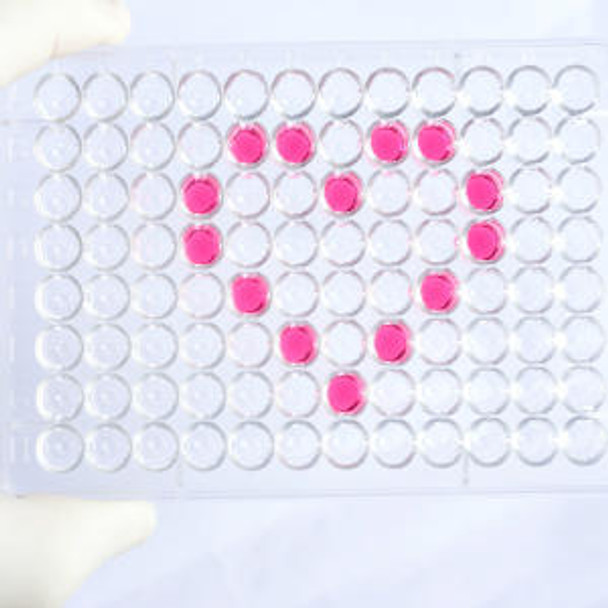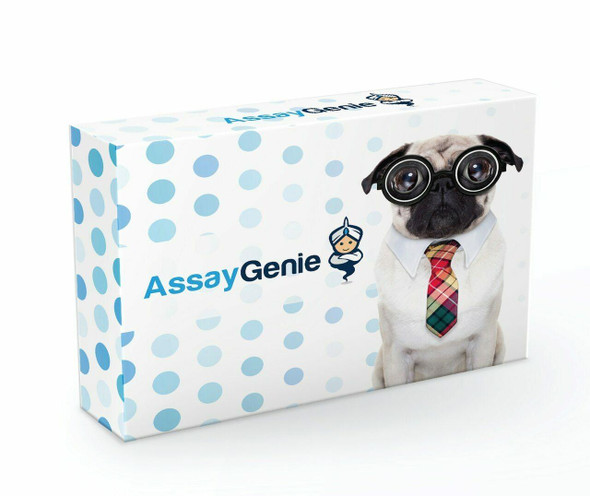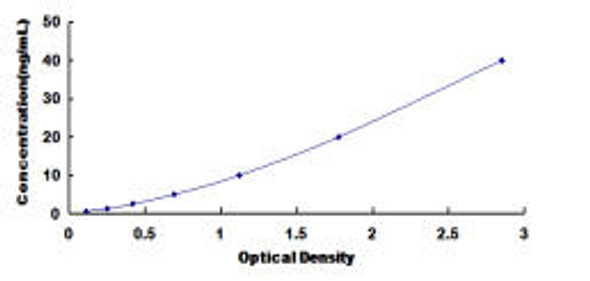Human Latent-transforming growth factor beta-binding protein 2 (LTBP2) ELISA Kit (HUEB1840)
- SKU:
- HUEB1840
- Product Type:
- ELISA Kit
- Size:
- 96 Assays
- Uniprot:
- Q14767
- Range:
- 0.156-10 ng/mL
- ELISA Type:
- Sandwich
- Synonyms:
- LTBP2, LTBP-2, C14orf141, GLC3D, latent transforming growth factor beta binding protein 2, LTBP3, chromosome 14 open reading frame 141, Latent TGF-beta bp2
- Reactivity:
- Human
Description
Human Latent-transforming growth factor beta-binding protein 2 (LTBP2) ELISA Kit
The Human Latent Transforming Growth Factor Beta Binding Protein 2 (LTBP2) ELISA Kit is specifically designed for the accurate detection of LTBP2 levels in human serum, plasma, and cell culture supernatants. This kit offers high sensitivity and specificity, ensuring precise and reliable results for a variety of research applications.LTBP2 is a key protein that plays a crucial role in regulating the transforming growth factor beta (TGF-β) signaling pathway. It is involved in extracellular matrix assembly and is essential for the proper function of various tissues and organs.
Abnormal LTBP2 expression has been linked to various diseases, including fibrosis, cancer, and developmental disorders, making it a valuable biomarker for studying these conditions and exploring potential therapeutic interventions.With its advanced technology and user-friendly design, the Human LTBP2 ELISA Kit is an essential tool for researchers studying the role of LTBP2 in health and disease. Get reliable and reproducible results with this high-quality kit, and unravel the mysteries of LTBP2 biology with confidence.
| Product Name: | Human Latent-transforming growth factor beta-binding protein 2 (LTBP2) ELISA Kit |
| SKU: | HUEB1840 |
| Size: | 96T |
| Target: | Human Latent-transforming growth factor beta-binding protein 2 (LTBP2) |
| Synonyms: | LTBP-2, C14orf141, LTBP3 |
| Assay Type: | Sandwich |
| Detection Method: | ELISA |
| Reactivity: | Human |
| Detection Range: | 0.156-10ng/mL |
| Sensitivity: | 0.039ng/mL |
| Intra CV: | 4.0% | ||||||||||||||||||||
| Inter CV: | 7.2% | ||||||||||||||||||||
| Linearity: |
| ||||||||||||||||||||
| Recovery: |
| ||||||||||||||||||||
| Function: | May play an integral structural role in elastic-fiber architectural organization and/or assembly. |
| Uniprot: | Q14767 |
| Sample Type: | Serum, plasma, tissue homogenates, cell culture supernates and other biological fluids |
| Specificity: | Natural and recombinant human Latent-transforming growth factor beta-binding protein 2 |
| Sub Unit: | Forms part of the large latent transforming growth factor beta precursor complex; removal is essential for activation of complex (PubMed:7798248). Interacts with SDC4 (PubMed:20382221). Interacts (via C-terminal domain) with FBN1 (via N-terminal domain) in a Ca(+2)-dependent manner (PubMed:17293099). |
| Research Area: | Signal Transduction |
| Subcellular Location: | Secreted Extracellular space Extracellular matrix |
| Storage: | Please see kit components below for exact storage details |
| Note: | For research use only |
| UniProt Protein Function: | LTBP2: May play an integral structural role in elastic-fiber architectural organization and/or assembly. Defects in LTBP2 are the cause of primary congenital glaucoma type 3D (GLC3D). An autosomal recessive form of primary congenital glaucoma (PCG). PCG is characterized by marked increase of intraocular pressure at birth or early childhood, large ocular globes (buphthalmos) and corneal edema. It results from developmental defects of the trabecular meshwork and anterior chamber angle of the eye that prevent adequate drainage of aqueous humor. Defects in LTBP2 are the cause of microspherophakia (MCSPH). It is a rare disease characterized by smaller and more spherical lenses than normal bilaterally, an increased anteroposterior thickness of the lens and highly myopic eyes. Lens dislocation or subluxation may occur, leading to defective accommodation. Defects in LTBP2 are the cause of Weill-Marchesani syndrome 3 (WMS3). A rare connective tissue disorder characterized by short stature, brachydactyly, joint stiffness, and lens abnormalities. Belongs to the LTBP family. |
| UniProt Protein Details: | Protein type:Secreted; Secreted, signal peptide Chromosomal Location of Human Ortholog: 14q24 Cellular Component: extracellular matrix; extracellular space; proteinaceous extracellular matrix Molecular Function:heparin binding; protein binding; growth factor binding; calcium ion binding Biological Process: transforming growth factor beta receptor signaling pathway; protein secretion; protein targeting Disease: Glaucoma 3, Primary Congenital, D; Microspherophakia And/or Megalocornea, With Ectopia Lentis And With Or Without Secondary Glaucoma; Glaucoma 3, Primary Infantile, B; Weill-marchesani Syndrome 3 |
| NCBI Summary: | The protein encoded by this gene belongs to the family of latent transforming growth factor (TGF)-beta binding proteins (LTBP), which are extracellular matrix proteins with multi-domain structure. This protein is the largest member of the LTBP family possessing unique regions and with most similarity to the fibrillins. It has thus been suggested that it may have multiple functions: as a member of the TGF-beta latent complex, as a structural component of microfibrils, and a role in cell adhesion. [provided by RefSeq, Jul 2008] |
| UniProt Code: | Q14767 |
| NCBI GenInfo Identifier: | 296439311 |
| NCBI Gene ID: | 4053 |
| NCBI Accession: | Q14767.3 |
| UniProt Related Accession: | Q14767 |
| Molecular Weight: | |
| NCBI Full Name: | Latent-transforming growth factor beta-binding protein 2 |
| NCBI Synonym Full Names: | latent transforming growth factor beta binding protein 2 |
| NCBI Official Symbol: | LTBP2 |
| NCBI Official Synonym Symbols: | WMS3; GLC3D; LTBP3; MSPKA; MSTP031; C14orf141 |
| NCBI Protein Information: | latent-transforming growth factor beta-binding protein 2 |
| UniProt Protein Name: | Latent-transforming growth factor beta-binding protein 2 |
| Protein Family: | Latent-transforming growth factor beta-binding protein |
| UniProt Gene Name: | LTBP2 |
| UniProt Entry Name: | LTBP2_HUMAN |
| Component | Quantity (96 Assays) | Storage |
| ELISA Microplate (Dismountable) | 8×12 strips | -20°C |
| Lyophilized Standard | 2 | -20°C |
| Sample Diluent | 20ml | -20°C |
| Assay Diluent A | 10mL | -20°C |
| Assay Diluent B | 10mL | -20°C |
| Detection Reagent A | 120µL | -20°C |
| Detection Reagent B | 120µL | -20°C |
| Wash Buffer | 30mL | 4°C |
| Substrate | 10mL | 4°C |
| Stop Solution | 10mL | 4°C |
| Plate Sealer | 5 | - |
Other materials and equipment required:
- Microplate reader with 450 nm wavelength filter
- Multichannel Pipette, Pipette, microcentrifuge tubes and disposable pipette tips
- Incubator
- Deionized or distilled water
- Absorbent paper
- Buffer resevoir
*Note: The below protocol is a sample protocol. Protocols are specific to each batch/lot. For the correct instructions please follow the protocol included in your kit.
Allow all reagents to reach room temperature (Please do not dissolve the reagents at 37°C directly). All the reagents should be mixed thoroughly by gently swirling before pipetting. Avoid foaming. Keep appropriate numbers of strips for 1 experiment and remove extra strips from microtiter plate. Removed strips should be resealed and stored at -20°C until the kits expiry date. Prepare all reagents, working standards and samples as directed in the previous sections. Please predict the concentration before assaying. If values for these are not within the range of the standard curve, users must determine the optimal sample dilutions for their experiments. We recommend running all samples in duplicate.
| Step | |
| 1. | Add Sample: Add 100µL of Standard, Blank, or Sample per well. The blank well is added with Sample diluent. Solutions are added to the bottom of micro ELISA plate well, avoid inside wall touching and foaming as possible. Mix it gently. Cover the plate with sealer we provided. Incubate for 120 minutes at 37°C. |
| 2. | Remove the liquid from each well, don't wash. Add 100µL of Detection Reagent A working solution to each well. Cover with the Plate sealer. Gently tap the plate to ensure thorough mixing. Incubate for 1 hour at 37°C. Note: if Detection Reagent A appears cloudy warm to room temperature until solution is uniform. |
| 3. | Aspirate each well and wash, repeating the process three times. Wash by filling each well with Wash Buffer (approximately 400µL) (a squirt bottle, multi-channel pipette,manifold dispenser or automated washer are needed). Complete removal of liquid at each step is essential. After the last wash, completely remove remaining Wash Buffer by aspirating or decanting. Invert the plate and pat it against thick clean absorbent paper. |
| 4. | Add 100µL of Detection Reagent B working solution to each well. Cover with the Plate sealer. Incubate for 60 minutes at 37°C. |
| 5. | Repeat the wash process for five times as conducted in step 3. |
| 6. | Add 90µL of Substrate Solution to each well. Cover with a new Plate sealer and incubate for 10-20 minutes at 37°C. Protect the plate from light. The reaction time can be shortened or extended according to the actual color change, but this should not exceed more than 30 minutes. When apparent gradient appears in standard wells, user should terminatethe reaction. |
| 7. | Add 50µL of Stop Solution to each well. If color change does not appear uniform, gently tap the plate to ensure thorough mixing. |
| 8. | Determine the optical density (OD value) of each well at once, using a micro-plate reader set to 450 nm. User should open the micro-plate reader in advance, preheat the instrument, and set the testing parameters. |
| 9. | After experiment, store all reagents according to the specified storage temperature respectively until their expiry. |
When carrying out an ELISA assay it is important to prepare your samples in order to achieve the best possible results. Below we have a list of procedures for the preparation of samples for different sample types.
| Sample Type | Protocol |
| Serum | If using serum separator tubes, allow samples to clot for 30 minutes at room temperature. Centrifuge for 10 minutes at 1,000x g. Collect the serum fraction and assay promptly or aliquot and store the samples at -80°C. Avoid multiple freeze-thaw cycles. If serum separator tubes are not being used, allow samples to clot overnight at 2-8°C. Centrifuge for 10 minutes at 1,000x g. Remove serum and assay promptly or aliquot and store the samples at -80°C. Avoid multiple freeze-thaw cycles. |
| Plasma | Collect plasma using EDTA or heparin as an anticoagulant. Centrifuge samples at 4°C for 15 mins at 1000 × g within 30 mins of collection. Collect the plasma fraction and assay promptly or aliquot and store the samples at -80°C. Avoid multiple freeze-thaw cycles. Note: Over haemolysed samples are not suitable for use with this kit. |
| Urine & Cerebrospinal Fluid | Collect the urine (mid-stream) in a sterile container, centrifuge for 20 mins at 2000-3000 rpm. Remove supernatant and assay immediately. If any precipitation is detected, repeat the centrifugation step. A similar protocol can be used for cerebrospinal fluid. |
| Cell culture supernatant | Collect the cell culture media by pipette, followed by centrifugation at 4°C for 20 mins at 1500 rpm. Collect the clear supernatant and assay immediately. |
| Cell lysates | Solubilize cells in lysis buffer and allow to sit on ice for 30 minutes. Centrifuge tubes at 14,000 x g for 5 minutes to remove insoluble material. Aliquot the supernatant into a new tube and discard the remaining whole cell extract. Quantify total protein concentration using a total protein assay. Assay immediately or aliquot and store at ≤ -20 °C. |
| Tissue homogenates | The preparation of tissue homogenates will vary depending upon tissue type. Rinse tissue with 1X PBS to remove excess blood & homogenize in 20ml of 1X PBS (including protease inhibitors) and store overnight at ≤ -20°C. Two freeze-thaw cycles are required to break the cell membranes. To further disrupt the cell membranes you can sonicate the samples. Centrifuge homogenates for 5 mins at 5000xg. Remove the supernatant and assay immediately or aliquot and store at -20°C or -80°C. |
| Tissue lysates | Rinse tissue with PBS, cut into 1-2 mm pieces, and homogenize with a tissue homogenizer in PBS. Add an equal volume of RIPA buffer containing protease inhibitors and lyse tissues at room temperature for 30 minutes with gentle agitation. Centrifuge to remove debris. Quantify total protein concentration using a total protein assay. Assay immediately or aliquot and store at ≤ -20 °C. |
| Breast Milk | Collect milk samples and centrifuge at 10,000 x g for 60 min at 4°C. Aliquot the supernatant and assay. For long term use, store samples at -80°C. Minimize freeze/thaw cycles. |










